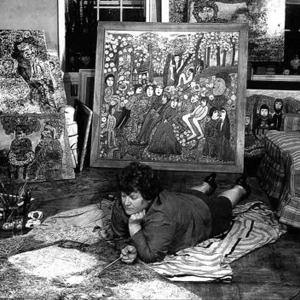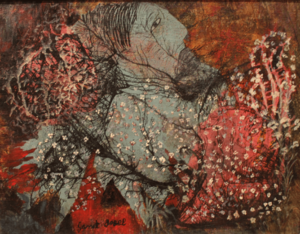Janet Sobel facts for kids
Quick facts for kids
Janet Sobel
|
|
|---|---|
 |
|
| Born |
Jennie Olechovsky
May 31, 1893 |
| Died | November 11, 1968 (aged 75) |
| Nationality | Ukrainian, American |
| Known for | Drip painting, all-over painting |
|
Notable work
|
Pro and Contra (1941), Through the Glass (1944), Milky Way (1945) |
| Movement | Abstract Expressionism |
| Spouse(s) | Max Sobel |
Janet Sobel (born Jennie Olechovsky, May 31, 1893 – November 11, 1968) was an important American painter. She was born in Ukraine and became famous for her unique style of Abstract Expressionism. Janet Sobel started painting when she was 45 years old, in 1938. She was a pioneer in using the drip painting technique, which later influenced famous artist Jackson Pollock. She was also recognized for creating some of the first "all-over paintings," where the entire canvas is covered evenly with paint.
Contents
Early Life and Artistic Beginnings
Janet Sobel was born Jennie Olechovsky in 1893 in Katerynoslav, which is now Dnipro, Ukraine. Her father, Baruch Olechovsky, was killed in a Russian pogrom (a violent attack against a specific group of people). In 1908, when she was 15, Janet moved to New York City with her mother and siblings. Her mother, Fannie Kinchuk, worked as a midwife.
At 16, Janet married Max Sobel. They had five children together. She began painting in 1937, while raising her family. She created both abstract art and figurative art (art that shows recognizable objects or people). Her son recognized her talent and helped share her artwork with other artists and important people in the art world.
Janet Sobel's Painting Career

Inspiration Behind Her Art
Janet Sobel believed in expressing herself freely, which led her to meet philosopher John Dewey. Dewey supported Sobel's art. In 1944, he wrote about her work for a gallery show. He said her art came from deep feelings and experiences, showing how colors and shapes came together beautifully.
Sobel often used music to inspire her paintings. She would let her feelings flow onto the canvas. Her art sometimes filled every empty space, which is a style called horror vacui. She also painted her past experiences, like soldiers and traditional Jewish families, reflecting her childhood in Ukraine. Art became a safe place for her imagination.
Impact of Art Critics
A well-known art critic named Clement Greenberg wrote about modern art during Sobel's time. He later recognized Sobel as an early artist in the Abstract Expressionism movement. However, he often compared her work to Jackson Pollock's, sometimes saying her art was "primitive" or that of a "housewife." This made it harder for her work to get the full recognition it deserved during her career.
Despite this, Peggy Guggenheim, a famous art collector, included Sobel's work in her gallery, The Art of This Century, in 1946. Sobel also had a solo show there.
Jackson Pollock himself admitted that Sobel's "drip paintings" made an impression on him. Greenberg later wrote that Sobel's work was the first "all-over" painting he had ever seen. He noted that her art changed from showing clear figures to a more abstract style of dripping paint.
Some critics described Sobel's paintings as being like "surrealism" (dream-like art) and "primitivism" (art that seems simple or raw). Calling her a "primitive" artist helped her get noticed, but it also limited how her art was seen. This label was part of a bigger effort to create a unique American art style, separate from European art. Sobel, as a "housewife" artist, also helped start conversations about the roles of women in art and society.
Notable Artworks
Janet Sobel's early paintings sometimes looked like the work of artists such as Marc Chagall. Her art often featured many flowers, similar to Ukrainian folk art. She also liked to use different materials, including sand, in her paintings. If her drip paintings weren't bright enough, she would outline them in ink. Even though she helped invent Abstract Expressionism, she continued to create art with clear images. Her main goal was to make her art visually strong and exciting.
One of her famous works, Milky Way, created in 1945, is now on display at the Museum of Modern Art in New York City.
Later Life and Legacy
Janet Sobel passed away at her home in Plainfield, New Jersey, in 1968. In 2021, The New York Times published an obituary for her, recognizing her important contributions to art.
See also
 In Spanish: Janet Sobel para niños
In Spanish: Janet Sobel para niños

